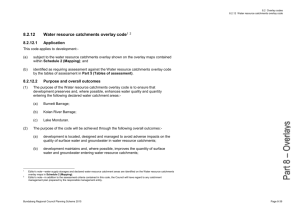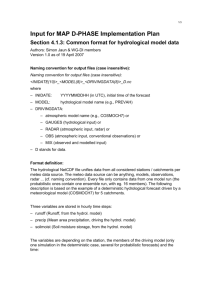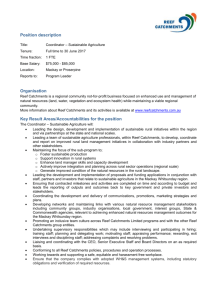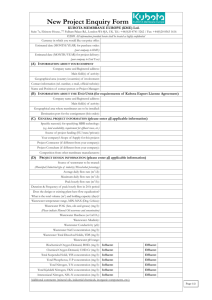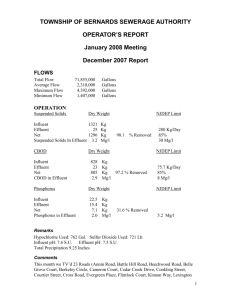Water resource catchments overlay code
advertisement
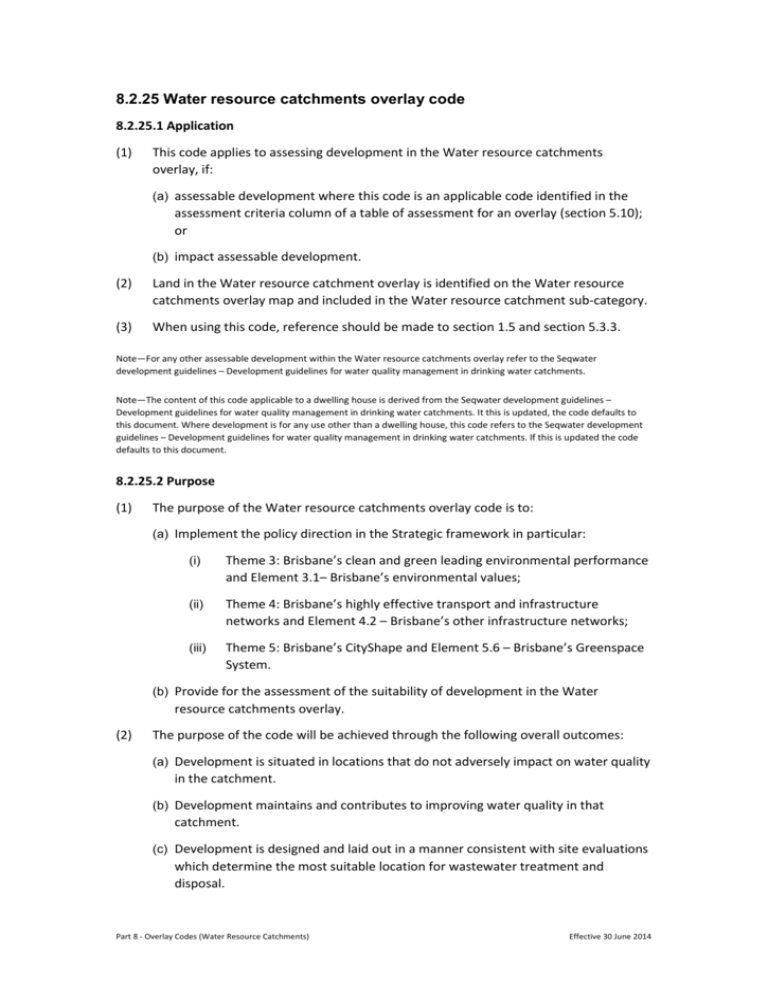
8.2.25 Water resource catchments overlay code 8.2.25.1 Application (1) This code applies to assessing development in the Water resource catchments overlay, if: (a) assessable development where this code is an applicable code identified in the assessment criteria column of a table of assessment for an overlay (section 5.10); or (b) impact assessable development. (2) Land in the Water resource catchment overlay is identified on the Water resource catchments overlay map and included in the Water resource catchment sub-category. (3) When using this code, reference should be made to section 1.5 and section 5.3.3. Note—For any other assessable development within the Water resource catchments overlay refer to the Seqwater development guidelines – Development guidelines for water quality management in drinking water catchments. Note—The content of this code applicable to a dwelling house is derived from the Seqwater development guidelines – Development guidelines for water quality management in drinking water catchments. It this is updated, the code defaults to this document. Where development is for any use other than a dwelling house, this code refers to the Seqwater development guidelines – Development guidelines for water quality management in drinking water catchments. If this is updated the code defaults to this document. 8.2.25.2 Purpose (1) The purpose of the Water resource catchments overlay code is to: (a) Implement the policy direction in the Strategic framework in particular: (i) Theme 3: Brisbane’s clean and green leading environmental performance and Element 3.1– Brisbane’s environmental values; (ii) Theme 4: Brisbane’s highly effective transport and infrastructure networks and Element 4.2 – Brisbane’s other infrastructure networks; (iii) Theme 5: Brisbane’s CityShape and Element 5.6 – Brisbane’s Greenspace System. (b) Provide for the assessment of the suitability of development in the Water resource catchments overlay. (2) The purpose of the code will be achieved through the following overall outcomes: (a) Development is situated in locations that do not adversely impact on water quality in the catchment. (b) Development maintains and contributes to improving water quality in that catchment. (c) Development is designed and laid out in a manner consistent with site evaluations which determine the most suitable location for wastewater treatment and disposal. Part 8 - Overlay Codes (Water Resource Catchments) Effective 30 June 2014 (d) Development including any associated ancillary activities or operations, is managed in a manner that contributes to maintaining and improving water quality in that catchment. (e) Development in the catchments is undertaken in such a manner as to ensure no cumulative impact on water quality. 8.2.25.3 Assessment criteria The following table identifies the assessment criteria for assessable development. Table 8.2.25.3—Criteria for assessable development Performance outcomes Acceptable outcomes Section A—If for a material change of use for a dwelling house PO1 AO1 Development ensures that a site analysis is undertaken to demonstrate that the development and activity is appropriate for the location. Development is demonstrated to be acceptable by a site analysis that is prepared in accordance with the Seqwater Development guidelines for water quality management in drinking water catchments, Table 1, measure 1.1. PO2 AO2 Development is appropriately located with horizontal separation distances to reduce potential adverse impacts on water quality, being appropriate for the location to maintain and improve water quality in the catchment. Development is carried out on land which: (a) accords with the horizontal separation distances in Table 3 in Development guidelines for water quality management in drinking water catchments; (b) is otherwise appropriately located, if there is no suitable alternative. PO3 AO3 Development provides for wastewater treatment and effluent disposal in a location determined in accordance with a site evaluation. Development accords with a site evaluation which addresses: (a) depth to bedrock and seasonal groundwater; (b) nature of site water supply; (c) local climatic conditions; (d) site stability; (e) soil profile in accordance with the relevant Australian Standard; (f) soil characteristics, particularly nutrient absorption capacity, dispersion potential, permeability, depth and structure. Part 8 - Overlay Codes (Water Resource Catchments) Effective 30 June 2014 Note—The Seqwater development guidelines provide guidance on relevant matter’s for a site evaluation. PO4 AO4 Development provides a wastewater treatment system which is certified under the Plumbing and Drainage Act 2002. Development provides a wastewater treatment system which includes: (a) a disinfection process to achieve the required microbiological quality and processes including chlorination, UV radiation, oxidation or membrane processes as per the Queensland Plumbing and Wastewater Code 2006; (b) an emergency storage capacity of 1,000L and adequate buffering for shock loading and down time. PO5 AO5 Development provides a wastewater treatment system which produces: Development provides: (a) a minimum secondary treated effluent (90th percentile); or (b) where deemed appropriate, a higher level of treatment, to preserve water quality and minimise human health risks. (a) secondary treated effluent system which is characterised by: (i) biochemical oxygen demand less than or equal to 20mg/L with no sample over 30mg/L; (ii) total suspended solids less than 30mg/L – with no sample over 45mg/L; (iii) faecal coliforms less than 200cfu/100mL with no sample over 1000cfu/L; or Note—Refer to the Queensland Plumbing and Wastewater Code 2006. (b) a composting or other alternative waste treatment system which ensures that the treated material does not cause an adverse impact on water quality through material allowing nutrients to enter surface waters or groundwater systems, including where the treated material is used for fertiliser or other soil improvement or otherwise disposed of. PO6 AO6.1 Development locates the effluent disposal Development locates the effluent disposal Part 8 - Overlay Codes (Water Resource Catchments) Effective 30 June 2014 application area to achieve no additional effect on water quality. application area to: (a) comply with the Queensland Plumbing and Wastewater Code 2006; (b) protect public health; (c) protect surface water and groundwater quality, including diversion mounds up slope of the effluent disposal application area, so that these waters do not flow onto or across effluent disposal application area. AO6.2 Development locates the effluent disposal application area, inclusive of any reserve area: (a) to achieve the horizontal separation distances in the Development guidelines for water quality management in drinking water catchments; (b) on land with a low capability of becoming unstable or collapsing during construction or operation; (c) on land that is not susceptible to salinisation; (d) where the area has a good aspect for enhanced exposure to sunlight and prevailing breezes; (e) on land that is free of or not susceptible to depressions where run-off may pond on the effluent disposal application area; (f) on land with soils with a permeability between 0.06m/day and 3.0m/day; (g) on land that does not contain rock outcrops, faults, areas underlain by fractured rock, coarse alluvium or similar which may short circuit wastewater to groundwater; (h) on land where the base of the land application field is at least 2m above the seasonal high watertable or bedrock, whichever is the lesser vertical distance below the base of the effluent disposal application area; Part 8 - Overlay Codes (Water Resource Catchments) Effective 30 June 2014 (i) on land which is not in an overland flow path or on an area that performs a groundwater recharge or discharge function. PO7 AO7.1 Development provides for the monitoring and maintenance of treatment and disposal systems to sustain the quality of effluent and achieve no additional effect on water quality. Development provides for monitoring of the effluent disposal system to be undertaken from the time of commissioning to determine the quality of the wastewater produced from the effluent treatment system. AO7.2 Development provides for the monitoring of soils, vegetation and groundwater in the effluent disposal application area to be undertaken every 3 years to establish that the treated effluent is not percolating into groundwater. AO7.3 Development provides for the sampling and testing to be undertaken through an accredited laboratory. AO7.4 Development provides for: (a) continuous monitoring by the owner of the effluent disposal system to be undertaken, for any water on the surface of the effluent disposal application area, down slope resurfacing, change in plant growth on or around the effluent disposal application area and any other sign of a problem; (b) any problem detected during continuous monitoring to be addressed through maintenance. Section B—If for a material change of use other than for a dwelling house PO8 AO8 Development is to comply with the specific outcomes of the Development guidelines for water quality management in drinking water catchments as if the specific outcomes are performance outcomes. Development is to comply with the measures in the Development guidelines for water quality management in drinking water catchments as if the measures are acceptable outcomes. Part 8 - Overlay Codes (Water Resource Catchments) Effective 30 June 2014 Part 8 - Overlay Codes (Water Resource Catchments) Effective 30 June 2014

